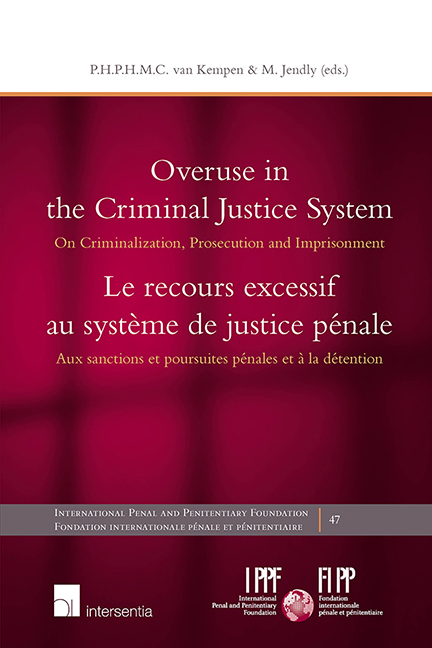Book contents
- Frontmatter
- Dedication
- Contents
- Acknowledgements
- Remerciements
- PART I INTRODUCTORY SYNTHESIS AND ANALYSES 1ÈRE PARTIE. SYNTHÈSE ET ANALYSES INTRODUCTIVES
- PART II THEMES 2ÈME PARTIE. THÈMES
- Overuse of the Criminal Justice System: Analytical Approach, Rules and Practices
- The Overuse of Criminal Justice in the Case Law of the European Court of Human Rights
- Overuse of Criminalization: a Philosophical and Political Approach on the Latin-American Situation
- Overprosecution and Negotiated Justice in Europe
- The American Experience with the Prosecutorial Overuse of Plea Bargaining
- Overuse of Imprisonment: Statistical Analyses of Incarceration Rates Across the World
- Minimising Prisonisation and the Harms of Custody
- Criminal Policy and Imprisonment. The Case of Lithuania: Open Prisons, Prison Leave and Release on Parole
- PART III NATIONAL REPORTS 3ÈME PARTIE. RAPPORTS NATIONAUX
- The International Penal and Penitentiary Foundation: history and purpose
- La Fondation internationale pénale et pénitentiaire: histoire et objectif
- The IPPF Series
Overuse of Imprisonment: Statistical Analyses of Incarceration Rates Across the World
from PART II - THEMES 2ÈME PARTIE. THÈMES
Published online by Cambridge University Press: 26 June 2019
- Frontmatter
- Dedication
- Contents
- Acknowledgements
- Remerciements
- PART I INTRODUCTORY SYNTHESIS AND ANALYSES 1ÈRE PARTIE. SYNTHÈSE ET ANALYSES INTRODUCTIVES
- PART II THEMES 2ÈME PARTIE. THÈMES
- Overuse of the Criminal Justice System: Analytical Approach, Rules and Practices
- The Overuse of Criminal Justice in the Case Law of the European Court of Human Rights
- Overuse of Criminalization: a Philosophical and Political Approach on the Latin-American Situation
- Overprosecution and Negotiated Justice in Europe
- The American Experience with the Prosecutorial Overuse of Plea Bargaining
- Overuse of Imprisonment: Statistical Analyses of Incarceration Rates Across the World
- Minimising Prisonisation and the Harms of Custody
- Criminal Policy and Imprisonment. The Case of Lithuania: Open Prisons, Prison Leave and Release on Parole
- PART III NATIONAL REPORTS 3ÈME PARTIE. RAPPORTS NATIONAUX
- The International Penal and Penitentiary Foundation: history and purpose
- La Fondation internationale pénale et pénitentiaire: histoire et objectif
- The IPPF Series
Summary
INTRODUCTION
An unprecedented expansion of penal control has occurred in recent decades in different parts of the world. Since the mid-1970s, North American imprisonment rates have increased nearly fivefold. Many other countries followed from the 1980s onwards, in Africa, Asia, Europe, South America and Oceania. This has resulted to high imprisonment rates and severe overcrowding. In 2016, more than two out of three countries have an occupancy rate of over 100%. In the worst cases, the number of prisoners exceeds the number of prison places by three to one.
This text gives an overview of major trends in the use of imprisonment across the world. Trends and differences in imprisonment rates are examined both cross-sectionally and over time.
Imprisonment rates. In the following, the use of imprisonment is examined mainly in terms of imprisonment rates / 100,000 population. Imprisonment rates indicate how many of its residents the state keeps in prison on any given day (Stock-statistics). The main data-source is the World Prison Brief database (WPB). The database is hosted by the Institute for Criminal Policy Research (ICPR), at Birkbeck University of London. The WPB holds statistics for 223 independent countries and dependent territories. For most countries, there is also data on specific categories of prisoners, including juveniles, persons detained in pre-trial or prior to sentencing, female prisoners and foreigners. Other sources include the Council of Europe data from the SPACE I project. It allows more exact comparisons between European countries by providing standardized (adjusted) figures through the use of identical counting methods. The third source of information includes national time-series, dating back to the early 1960s or early 1980s.
Besides stock-based imprisonment rates, the use of imprisonment can also be measured by the number of people admitted to prison (flow-statistics), or by the length of served prison terms. Both measures provide complementary information about a country's prison profile. On the other hand, imprisonment rates (as stock-statistics) are a function of the number of entries and the duration of stay. It thus tells more than either of these two options alone and is the most complete basic indicator for the use of imprisonment.
- Type
- Chapter
- Information
- Overuse in the Criminal Justice SystemOn Criminalization, Prosecution and Imprisonment, pp. 165 - 212Publisher: IntersentiaPrint publication year: 2019
- 1
- Cited by



